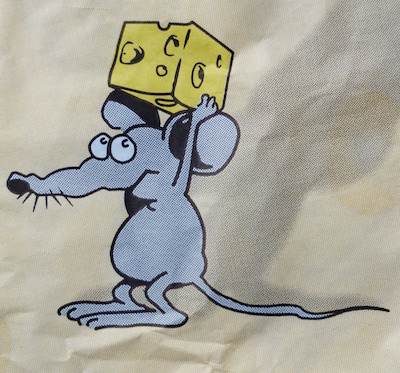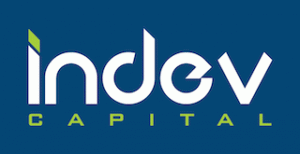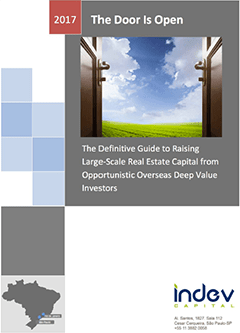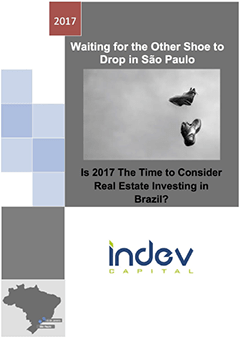
In Sao Paulo, when people ask me if I was surprised by the result of the US election I tell them that I felt like I was in an airplane that had reached a 36,000 feet cruising altitude, I just had a nice glass of wine (let’s assume I was in first class!), and I looked out the window and saw a large flying pig, similar to the picture on the left, right next to the plane flying at 36,000 feet in the air at around 550 miles per hour. I was that surprised by the winner and the margin of victory.
What ON EARTH does A Flying Pig have to do with Sale Leaseback in Brazil?
While not quite as dramatic, I have been quite surprised by the Sale Leaseback market of Brazil. Why? It is an asset class that can achieve much of what foreign investors desire in a Brazil investment while at the same time remaining a very inefficient market in Brazil. There is a significant arbitrage opportunity based on the current lack of liquidity in Brazil and where Brazil is in its economic cycle.
The investment opportunity is a result of the credit crisis in Brazil. This crisis has even affected large multinational branches and the top Brazilian international companies, The crisis has changed their method of financing operations, consequently seeking a better ratio between cost of capital and long-term resources. The investment opportunities created have several attractive characteristics including, but not limited to, the following: one, high quality tenants; two, strategically important operational assets to the potential lessors; three, a high terminal value if the client moves out at the end of the lease or for some reason before; four, no development risk; five, top-tier locations; six, at least ten-year lease terms; and seven, sometimes an equal or higher yield than a BTS development. Another Flying Pig Indeed!
History of Sale LeaseBack (S&LB) in Brazil Market history and Potential of Sale & Leaseback in Brazil:
In the past, there was no market for Sale Leaseback in Brazil. The lack of this product is directly connected to Brazil’s very difficult inflationary history. In fact, in March 1992 inflation reached 84.3% per month. Although this period is long past, as seen by the past decade’s annual inflation average of 6%, this inflationary history has had an immense impact on the thinking of the population and decision makers of the usage and management of corporate balance sheets of Brazil’s industries.
Until recently, S&LB was not an established market in Brazil. The reasons are the following:
- Rent is indexed to inflation in Brazil. Therefore, due to the inflationary history it was nearly impossible to make capital budget decisions in this environment if a company did not own its assets.
- Corporate Real Estate was not only an inflation protector but also a store of value.
- Corporate Real Estate drove collateral value and access to credit.
- During Brazil’s earlier industrial expansion, land was cheap and for larger companies the government development bank helped corporations build factories in locations outside of city centers. These areas, as the cities have grown, have become part of the urban core. This has greatly enhanced the value of the properties.
What Changed – The Cheese Moved
 One of the biggest shifts in Brazil has been the current limited access to long-term corporate credit. There has never been significant commercial real estate development credit in the Brazilian system but there has been significant credit at the corporate level. This lack of project-level credit is the reason that investors do not see commercial office property distress at the level expected.
One of the biggest shifts in Brazil has been the current limited access to long-term corporate credit. There has never been significant commercial real estate development credit in the Brazilian system but there has been significant credit at the corporate level. This lack of project-level credit is the reason that investors do not see commercial office property distress at the level expected.
The recent financial and just-solved political crisis greatly increased the cost of capital and restricted credit even to strong multinational divisions and large international Brazilian companies with positive credit histories.
The select companies that do have access to credit lines have had a significant increase in their cost of financing, due to a higher interest rate in Brazil in the last years. The consequence was an increase in the cost of capital by accessing very expensive and short-term money that was available. Currently, there is very little long-term credit available for long-term capital needs.
S&LB has become an increasingly attractive alternative as it is long term AND currently, even at high investor yields, is at a significantly lower price than a similar bank credit instrument.
The executives of both top-tier international Brazilian companies and multinational companies with operations in Brazil are increasingly focused on return on equity and have become much more sophisticated with regards to the management of their capital budget decisions. As the inflation rate has been under relative control in recent years, these executives view the world more similarly to an executive in a developed economy than in the past. They now often question whether owning a large real estate asset is the best use of precious and limited capital at this time in their company’s development.
Finally, many multinational companies with offices in Brazil are starting to work independently from their foreign parent. Often the parent company desires the subsidiary to fund its own operations as much as possible. Hence, the parent company would rather the Brazilian subsidiary sell its land assets than the parent have to invest new fresh capital. Local executives in Brazil receive pushback when they do not pursue S&LB and BTS strategies.
Important Characteristics of S&LB Investments
De-Coupling Brazil Risk or How to Avoid a Dead-End (see picture to the left):
Due to the credit crisis, it is now possible to create S&LB investments with top-tier multinational and top-tier Brazilian companies. The S&LB contracts are for ten years and are enforceable via article 54-A of law 8.245/1991. Section A of article 54 was created in 2012, to update the original 1991 law to establish specific legal status of BTS and S&LB contracts.
These top-tier companies have significant value tied to properties on their balance sheets and now desire to execute S&LB transactions. Importantly, as the Brazilian economy seems to have started its recovery, these companies desire capital to take advantage of the numerous opportunities that cash provides in a time of cheap assets. Top-tier companies are not selling the assets due to a financial problem but instead to take advantage of an opportunity. This is not a desperation S&LB sale.
Importantly, in contrast to these top-tier companies (the focus of this newsletter), there are a large number of desperation S&LB sales in the current environment. The successful execution of a sale leaseback acquisition strategy requires an investor to source a local sponsor with rigorous credit analysis skills. In fact, without this local partner an investor can spend years looking at “dead-end” S&LB opportunities that can waste significant time and money. Unfortunately, InDev has seen investors try to go alone on Sale Leaseback strategies and this strategy has been exactly as the picture, a dead end.
Proven Demand – Built in Contract:
Contract lengths are often at least 10 years. Through InDev’s experience in the market, we see about 70% of S&LB contracts are for 10 years and 30% of S&LB contracts are between 10 and 15 years.
In addition to contract length and tenant credit, it is important to always focus on S&LB assets in a location/region with proven demand. In addition, it is important to focus strictly on light industrial or logistics assets. The general nature of these types of assets greatly facilitates renting the asset in the case of termination of a contract in 10 years or if for some reason the tenant leaves before the end of the contract period. Assets with these characteristics allow for exit in less than 5 years.
Fast Time to Cash Flow (Stabilization):
As the asset is a S&LB, there is immediate cash flow. Normally, there is zero to very little renovation done and no rent holidays. Unlike Commercial Properties, there is no rent revision in three years. While this does not allow for the huge potential rental increases, usually rent increases are only equivalent to inflation, it also does not permit the rent reductions that the commercial office market has faced in Brazil.
Simple Operations:
Investors can source a local co-investor sponsor and asset manager that will handle the property management, maintenance, collections, and legal issues. The local sponsor will also oversee the documentation of the property, together with the tenant, including all licenses, permits, and insurance. Importantly, a local sponsor must have experience in successful exits and using leverage to boost returns. Track record matters as always.
Asymmetric Information = High Yield to Cost = Happy Investor
 As the S&LB market is not mature, there is still significant asymmetry of information in the marketplace. Oftentimes, the price paid in S&LB is lower than the asset’s intrinsic value. Why? Companies prefer to sell the asset directly without using intermediaries, as they don’t want to pay a brokerage fee. These owners, rightly or wrongly, believe that they have sufficient direct contacts to sell the property and see no reason to pay a fee. In addition, there are limited professional and/or for-sale databases that allow for more perfect information.
As the S&LB market is not mature, there is still significant asymmetry of information in the marketplace. Oftentimes, the price paid in S&LB is lower than the asset’s intrinsic value. Why? Companies prefer to sell the asset directly without using intermediaries, as they don’t want to pay a brokerage fee. These owners, rightly or wrongly, believe that they have sufficient direct contacts to sell the property and see no reason to pay a fee. In addition, there are limited professional and/or for-sale databases that allow for more perfect information.
This lack of information results in a less efficient market. In addition, through the minimized involvement of professional brokers, there is greater proprietary deal flow in S&LB. This can create a very attractive opportunity for those with capital in Brazil currently.
Surprisingly, due to the lack of information in the S&LB market, S&LB transactions can achieve and sometimes even surpass the same yield to cost of a BTS of similar quality. The BTS market has more perfect information and therefore tends to have much more efficient pricing. The BTS market is more mature and there are sometimes very professionally managed competitive bid processes.
Importantly, this asymmetric information opportunity will not last forever in S&LB. It is unique and the biggest investment opportunity is now. The market will likely mature rapidly.
Limited Competition:
As stated earlier, with a top-tier sponsor, an investor will not need to participate in a bid process to obtain good S&LB assets. It is critical that the local sponsor have direct contact with family offices and main executives and shareholders of top-tier national companies and multinational companies. These contacts create the relationships with which an investor can avoid brokers to gain access to good opportunities. This direct contact is usually the result of a sponsor’s long-term relationships.
Comparable Transactions and Assets Exist:
It is essential to know how the asset can become liquid. Although the market is inefficient, there are a significant number of comparables available via sponsors who specialize in this marketplace. Importantly, family offices and local institutional investors are large buyers of these types of assets.
Limited Downside:
There are 3 “pillars” in the decision process of an S&LB or a BTS: one, the company’s credit; two, the asset characteristics; and three, the structure of the transaction. The structure of the transaction includes not only the length of the contract but also a bank guarantee to insure, for example, that the investor receives at least 3 years of rent should the tenant leave before the end of the contract. Occasionally, a portion of the long-term lease payment of the property is placed in an escrow account to insure against the eventual default by the tenant. Following these 3 pillars and completing the stages, it it possible to greatly reduce and limit the downside risk.
Deals of Scale Available:
Due to the facts that each asset’s size can be quite large, between US$15M and US$30M+ value, AND many companies are going to free up cash to execute their business strategy in an environment with little available credit, there is an excellent opportunity of scale currently. InDev believes that this is at least a US$50M to US$150M JV opportunity with a credible sponsor.
Opportunistic Returns:
Investors with available capital to acquire properties in cash will have a significant advantage over other buyers. In Brazil, S&LB acquisitions are often done in installments with a low deposit and an extended payment period. A full lump sum payment will create significant negotiating leverage with the seller. We see going in cash-on-cash yields of 10.0% to 13.0% with an average spread of 200 bps upon exit in today’s market environment. Currently, transactions model out at 15-20% IRR unlevered and 25-30% IRR levered.
Next Steps
This type of “Flying Pig” investment opportunity exists in Brazil at this time in the cycle. InDev is currently working with a local sponsor to put together a pipeline of at least US$50M to demonstrate the S&LB opportunity in early December. By the way, please look out for Flying Pigs on your next flight!
Warm Regards,
Joseph W. Williams
CEO & Founder InDev Capital
If you want to receive our newsletter:
Follow us at InDev Capital




